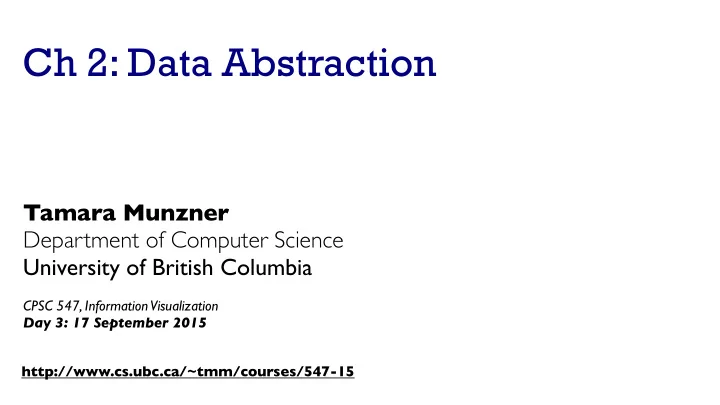

Ch 2: Data Abstraction Tamara Munzner Department of Computer Science University of British Columbia CPSC 547, Information Visualization Day 3: 17 September 2015 http://www.cs.ubc.ca/~tmm/courses/547-15
News • Waitlist update: 32 registered and waitlist cleared • Signup sheet - add yourself if you weren’t here before – probably just new auditors? 2
VAD Ch 2: Data Abstraction What? Datasets Attributes Data Types Attribute Types Categorical Items Attributes Links Positions Grids Data and Dataset Types Ordered Tables Networks & Fields Geometry Clusters, Trees Sets, Lists Ordinal Items Items (nodes) Grids Items Items Positions Attributes Links Positions Quantitative Attributes Attributes Dataset Types Ordering Direction Tables Networks Fields (Continuous) Sequential Grid of positions Attributes (columns) Link Items Cell (rows) Diverging Node (item) Cell containing value Attributes (columns) Value in cell Cyclic Multidimensional Table Trees Value in cell What? Geometry (Spatial) Why? Position How? [VAD Fig 2.1] 3
Dataset types Dataset Types Tables Networks Fields (Continuous) Geometry (Spatial) Grid of positions Attributes (columns) Link Items Cell Position (rows) Node (item) Attributes (columns) Cell containing value Value in cell Trees Multidimensional Table Value in cell 4
Dataset and data types Data and Dataset Types Tables Networks & Fields Geometry Clusters, Trees Sets, Lists Items Items (nodes) Grids Items Items Positions Attributes Links Positions Attributes Attributes Data Types Items Attributes Links Positions Grids Dataset Availability Static Dynamic 5
Attribute types Attribute Types Categorical Ordered Ordinal Quantitative Ordering Direction Sequential Diverging Cyclic 6
Further reading: Articles • Mathematics and the Internet: A Source of Enormous Confusion and Great Potential. Walter Willinger, David Alderson, and John C. Doyle. Notices of the AMS 56(5):586-599, 2009. • Rethinking Visualization: A High-Level Taxonomy. InfoVis 2004, p 151-158, 2004. • The Eyes Have It: A Task by Data Type Taxonomy for Information Visualizations Ben Shneiderman, Proc. 1996 IEEE Visual Languages • The Structure of the Information Visualization Design Space. Stuart Card and Jock Mackinlay, Proc. InfoVis 97. • Polaris: A System for Query, Analysis and Visualization of Multi-dimensional Relational Databases. Chris Stolte, Diane Tang and Pat Hanrahan, IEEE TVCG 8(1): 52-65 2002. 7
Further reading: Books • Visualization Analysis and Design. Munzner. CRC Press, 2014. – Chap 2: Data Abstraction • Information Visualization: Using Vision to Think. Stuart Card, Jock Mackinlay, and Ben Shneiderman. – Chap 1 • Data Visualization: Principles and Practice, 2nd ed. Alexandru Telea, CRC Press, 2014. • Interactive Data Visualization: Foundations, Techniques, and Applications, 2nd ed. Matthew O. Ward, Georges Grinstein, Daniel Keim. CRC Press, 2015. • The Visualization Handbook. Charles Hansen and Chris Johnson, eds. Academic Press, 2004. • Visualization Toolkit: An Object-Oriented Approach to 3D Graphics, 4th ed. Will Schroeder, Ken Martin, and Bill Lorensen. Kitware 2006. • Visualization of Time-Oriented Data. Wolfgang Aigner, Silvia Miksch, Heidrun Schumann, Chris Tominski. Springer 2011. 8
Now: In-class Design Exercise • Five time-series data scenarios – A: every 5 min, duration 1 year, 1 thing: building occupancy rates – B: every 5 min, 1 year, 2 things: currency exchange rates – C: several years and several things: 5 years, 10 currencies – D: 1 year, many things: 1000 machines (CPU load) – E: 1 year, several parameters, many things: 1 year, 10 params, 1000 machines • Group exercise: 15-20 min – one group per table (4 max), 10 groups total – discuss/sketch possible visual encodings appropriate for data assigned to your group • Reportback: 20-30 min – 2-3 min from each group • Design space: 15-20 min 9
Time-series data: Case A naive • extruded curves: detailed comparisons impossible [Cluster and Calendar based Visualization of Time Series Data. van Wijk and van Selow, Proc. InfoVis 99.] 10
Case A: Better Cluster-Calendar Solution • derived data: cluster hierarchy • juxtapose multiple views: calendar, superimposed 2D curves [Cluster and Calendar based Visualization of Time Series Data. van Wijk and van Selow, Proc. InfoVis 99.] 11
Case A: BinX [BinX: Dynamic Exploration of Time Series Datasets Across Aggregation Levels. Lior Berry and Tamara Munzner.] InfoVis 2004 Posters Compendium, pp 5-6. 12
Case B: [BinX: Dynamic Exploration of Time Series Datasets Across Aggregation Levels. Lior Berry and Tamara Munzner.] InfoVis 2004 Posters Compendium, pp 5-6. 13
Case E: LiveRAC video http://youtu.be/ld0c3H0VSkw [LiveRAC - Interactive Visual Exploration of System Management Time-Series Data. McLachlan, Munzner, Koutsofios, North. Proc. Conf. on Human Factors in Computing Systems (CHI) 2008, pp 1483-1492.] 14 14
Case E: LiveRAC data abstraction What? Tables • multidimensional table: time series data Why? Attributes (columns) – key attributes Items How? (rows) • time Cell containing value – 50,000: 5-minute intervals over 6 months – multiscale levels of interest Multidimensional Table • devices – 4000 • parameters – 20 Value in cell – ex: CPU usage, memory load, network traffic, alarms, ... – value attributes Attribute Types • parameter value for device at time point Ordered Categorical – quantitative Quantitative • device groups – categorical 15
Next Time • to read – VAD Ch. 3: Task Abstraction – Design Study Methodology: Reflections from the Trenches and the Stacks. Michael Sedlmair, Miriah Meyer, and Tamara Munzner. IEEE Trans. Visualization and Computer Graphics (Proc. InfoVis 2012), 18(12):2431-2440, 2012. • paper type: model 16
Recommend
More recommend